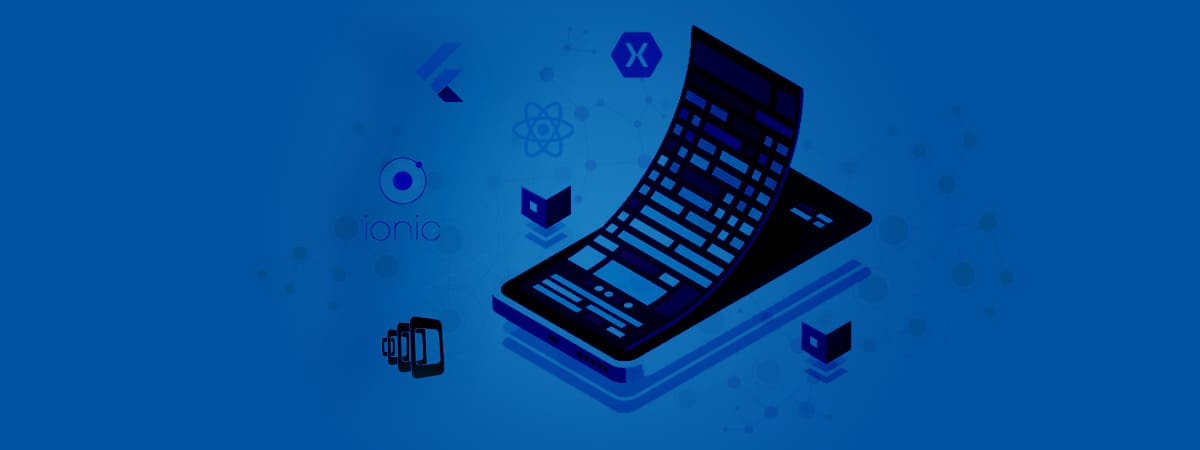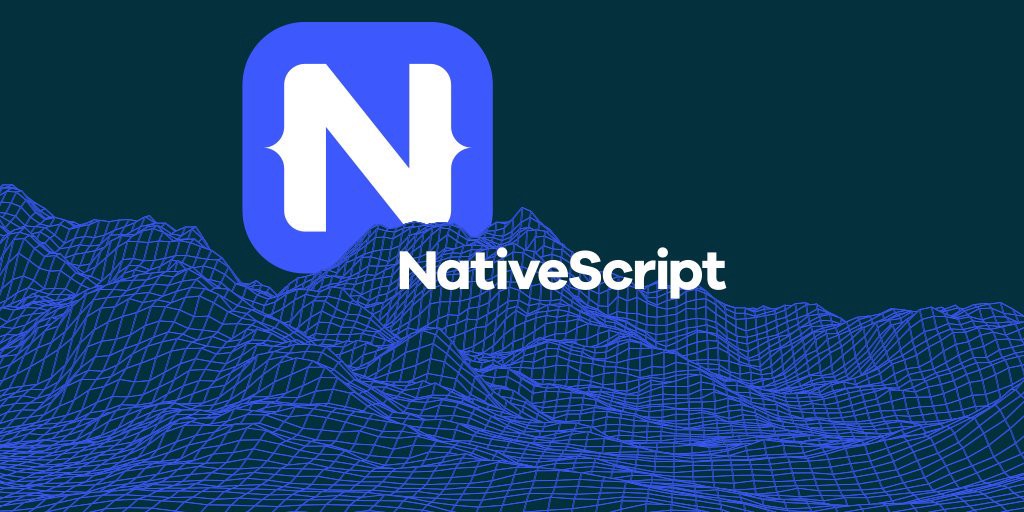
Cross-platform app development has its own merits which plays a major role in its current popularity. With the expansion of its reach, several cross-platforms app development tools and frameworks started to float in the market; slowly, and then all at once along with every other mobile app development company trying their hands at this interesting and one-of-a-kind technology.The result – We now have a sea of such tools and frameworks which you, as a developer, may find overwhelming. To help you out in your quest of finding the most ideal and exemplary cross-platform framework, here is a list of top 10 cross-platform app frameworks 2020 that are a sure thing.There are certain benchmarks that need to be cleared to declare something as “best” of that domain or category. In the same manner, while determining the best cross-platform frameworks, there were several prominent aspects that were considered, in order to truly see how every choice under inspection performed.However, before jumping on to the list, let’s get the basics out of the way.
What is a Cross-Platform Framework?

To be concise, cross-platform is a type of software that has the ability to run on multiple computing platforms i.e., Android, iOS, Windows, Blackberry, etc. The apps built on this framework do not require separate coding for each platform, rather coding once will create the foundation for the app to run as efficiently on all platforms. It is one of the most popular methods in the app development domain today, which almost all the top mobile app development companies swear upon.
Note: To gather an in-depth view, read this guide on cross-platform app development.
1. Ionic

Ionic is one of the most remarkable and popular cross-platform app frameworks, based on AngularJS. It allows developers to use a combination of many languages i.e., HTML5, JavaScript, and CSS and Cordova wrapper to access native platform controllers.
Ionic enables developers to create an impeccably creative user interface along with adding user-friendly features into the app. Apps developed with this framework are highly interactive and native-like, making Ionic a perfect candidate for PWA development as well.
Features
1. It is an open-source front-end framework meaning it allows alterations in the code structure, suitable to each developer and saves a lot of time. This gives hard competition to its contender Ionic, in the battle of Ionic vs React Native.
2. Ionic is based on a SAAS UI framework designed specifically for mobile operating systems. It provides numerous UI components for developing robust applications.
3. Another one of its most-appreciated features is that it is based on AngularJS, making it easy to offer extensions to HTML’s syntax, core functionalities to imbibe useful yet attractive features and components into the app.
4. This framework uses Cordova plugins which allow access to devices’ in-built features including Camera, GPS, and Audio Recorder, posing as one of the major benefits of cross-platform tools.
5. The fact that Ionic gives a native-like feel to the apps is what makes it a favorite of developers. It helps develop cross-platform apps and allows them to perform perfectly on various platforms.
2. React Native

When talking about cross platform app frameworks, it is hard not to include React Native. It is a framework built on JavaScript and is used to write real code and give the native-like feel to mobile applications that work both on Android and iOS. Due to its remarkable features, it is not only a preferred choice of developers but businesses also trust React Native as the right platform for their apps.
React Native integrates the benefits of JavaScript and React.JS along with providing the advantage to developers to write modules in Objective-C, Swift, or Java languages. Moreover, by using the native modules and libraries in the React Native cross-platform apps, developers can also perform heavy operations such as image editing, video processing or some other operations which are not part of the framework APIs.
Features
1. It is a good thing that React Native is an open-source cross-platform app framework, the same as Ionic. Because of this, it has a large community to support it and improve it by fixing bugs, improvising and introducing features.
2. One of the advantages of cross-platform development is that it requires one-time coding (WORA) for developing apps for platforms as diverse as Android and iOS. This solves one of the biggest challenges of other frameworks – requiring developers to code separately twice for the same app on different platforms.
3. One-time coding instantly reduces the development time of the app along with keeping the React Native app development cost to its lowest.
4. Impressively, React Native is highly compatible with third-party plugins, such as Google Maps.
5. React Native focuses on UI to a great extent rendering a highly responsive interface. What it means is that the React Native environment eliminates the time taken in loading and delivers a smooth interface to the applications.
3. Flutter

Google introduced an impressive cross-platform app framework named Flutter back in 2017. It is a software development kit designed to assist in the expeditious Android and iOS app development. It is also a fundamental and primary method for developing Google Fuschia apps.
Flutter offers apps that easily and effectively run on multiple platforms with uniformity and dynamicity.
Here are some of the remarkable features that make Flutter an ideal cross-platform framework among developers.
Features
1. Flutter promotes portable GPU, which renders UI power, allowing it to work on the latest interfaces.
2. Flutter does not require updating the UI contents manually, as it possesses a reactive framework. Flutter app Developers are only required to update the variables and the UI changes will be visible after that.
3. Flutter cross-platform app framework poses as a perfect choice for developing Minimum Viable Product (MVP) as it initiates an expeditious development process and is also cost-efficient.
4. Xamarin

Xamarin cross-platform app development framework is significantly different from the frameworks we have discussed so far. It is a streamlined framework used for developing apps for Android, Windows, and iOS with the help of C# and .Net, instead of JS libraries and HTML. It allows the developers to use 90% of the code for building an app for three distinct platforms.
Xamarin delivers applications with aesthetics like a native app with the help of its amazing APIs, something which makes the decision making a lot harder between Xamarin vs React Native. Here are Xamarin’s features explaining why it is one of the best choices of cross-platform frameworks for Mobile Development.
Features
1. Apps developed on the Xamarin framework are built using C# – a modern language having leverage over Objective-C and Java.
2. The developers get native-level app functionality with Xamarin. It reduces hardware compatibility problems to a great extent with the help of plugins and specific APIs, that work with common devices functionality.It also promotes linking with native libraries, allowing customization and native-level functionality. The feature alone, makes it one of the top Android app development framework.
3. Xamarin supports a direct inclusion of Objective-C, Java and C++ libraries. This allows developers to reuse many third-party codebases encrypted in Java, Objective-C or C++, making it one of the considerably preferred cross-platform frameworks.
4. Xamarin reduces the time and cost of mobile app development for it supports the WORA ( Write Once, Run Anywhere) and has a humongous collection of class libraries.
5. Xamarin offers robust compile-time checking. Because of this facility, developers witness fewer run-time errors and get well-functioning apps.
6. Xamarin has an astounding native user interface and controls assisting and allowing developers in designing a native-like app.
5. NativeScript

NativeScript passes as an amazing free cross-platform framework based on JavaScript. It wouldn’t be wrong to say that NativeScript is a preferable choice of developers looking for WORA functionality.
NativeScript also offers all native APIs, rendering an ability to the developers to reuse existing plugins straight from NPM into the projects.
Features
1. NativeScript renders beautiful, accessible, and platform-native UI, and that too without the WebViews. Developers are only required to define once and let the NativeScript adapt to run everywhere. They can even customize the UI to specific devices and screens.
2. As opposed to React Native, NativeScript provides developers with a complete web resource that comes loaded with plugins for all kinds of solutions. This inevitably eliminates the need for third-party solutions.
3. NativeScript gives the freedom to easily access native Android and iOS APIs, meaning developers don’t need any additional knowledge of native development languages.
4. It uses Angular and TypeScript for programming purposes.
6. Node.js

Node.js is an incredible framework for developing cross-platform apps. Essentially, Node.Js is a JavaScript runtime framework built on the Chrome V8 JavaScript engine. It is an open-source environment that supports the development of server-side and scalable networking apps. Node.js cross-platform apps are inherently highly efficient and responsive.
The framework is capable of handling several concurrent connections together. It also comes loaded with a rich library of numerous JavaScript modules that help in simplifying the development of web applications.
Features
1. All of the Node.js APIs are asynchronous, signifying that they are non-blocking in nature, meaning servers based on Node.JS do not essentially wait for data from APIs. It immediately moves on to another API after calling it. A notification mechanism for Node.js allows the server to get a response from the previous API call.
2. Node.js library is impressively speedy in its code execution process, for it is built on the Chrome’s V8 engine.
3. Node.js cross-platform apps do not buffer, instead, the applications output the data in chunks.
4. To deliver smooth and perfectly functioning applications, Node.js uses a single-threaded model with event looping functionality. This event mechanism enables the server to reply in a non-blocking way, making them scalable.
7. Appcelerator Titanium

Appcelerator is one of the many cross-platform app development tools designed to assist in smoother and easier mobile app development. It is a great way to create cross-platform apps with just a single code base. Its primary focus is on streamlining the app development process with the help of native components present in JavaScript code.
Features
1. Appcelerator offers various tools for rapid application development. This indicates that a prototype can be created with much less time and effort to evaluate user interaction with UI.
2. It has ArrowDB- a schema-less data store that allows developers to deploy data models with no additional efforts for setup.
3. It enables the integration of existing continuous delivery systems such as SCM solutions and more.
4. Appcelerator possesses pre-built connectors available for MS Azure, MS SQL, Salesforce, Box- the list is tediously long.
8. PhoneGap

Phone Gap (Cordova) is one of the impeccable cross-platform frameworks for mobile development that makes use of CSS, JavaScript, and HTML5. It also offers a cloud solution to developers providing them the choice to share the app in the development process for feedback from other developers.
It develops impressive apps by leveraging existing web technologies. Another great advantage of PhoneGap is that it entirely supports in-built device features such as GPS, Camera, Phonebook, Storage, and so on.
Features
1. PhoneGap is considered an impeccable cross-platform framework as it enables developers to create cross-platform apps using existing web technologies such as HTML 5, CSS3 and JavaScript.
2. Being a cross-platform framework, PhoneGap supports the use of a single code base to create apps for different platforms namely iOS, Android, Windows Phone, BlackBerry, etc.
3. It follows an architecture that is plugin-able in nature, meaning it is possible that the access to native device APIs can be extended in a modular way.
9. Sencha Touch

Introduced nearly a decade ago, Sencha Touch helps in developing web-based cross-platform apps and is typically used to create efficient applications that use the hardware acceleration techniques. By using Sencha Touch, developers are able to create well-tested, securely integrated UI components and libraries.
In fact, it is possible to develop large business apps and maintain them effectively and easily. Some of the remarkable features of it are:
Features
1. It is famous for providing built-in native-looking themes for all of the major platforms like Android, iOS, BlackBerry, Windows Phone, etc.
2. It comes with an effective agnostic backend data package for working with data sources.
3. One of the most celebrated features of Sencha Touch is that it supports Cordova integration for the native API access along with the packaging.
4. It offers code compatibility between new and old ones.
5. It comes loaded with customizable and 50+ built-in UI widgets. It also has a collection of rich UI like lists, carousels, forms, menus, and toolbars, etc., created specifically for mobile platforms.
10. Corona SDK

Corona SDK enables programmers to develop 2D mobile applications for all the major platforms, including Kindle and Windows.
It proffers to give 10X faster mobile and game app development. The framework le delivers remarkable results at the back of its backend framework’s reliability on Lua which is a lightweight and multi-paradigm programming language. The language focuses on the main elements of the development which are the speed, portability, extensibility, scalability, and last but not least, the ease of use.
What is more, it is a free-of-cost framework working both on Mac OS X and Windows while supporting real-time testing.
Features:
1. It has over 1000 APIs that give developers the ability to sprite animations, audio, and music, Box2D physics, object tweening, texture management, native elements, data- the list can go on for pages.
2. It responds to the code changes almost instantly while giving a real-time preview of the app’s performance as it would on a real device.
3. It supports almost 200 plugins including in-app advertising, analytics, media, and hardware features.
After considering all of the best options that a competent cross-platform app development company is looking for in this domain, there is nothing left but to wait and see how these frameworks compete with each other to stay in the competitive market, and how well they bode against the new frameworks entering the market as we speak.










